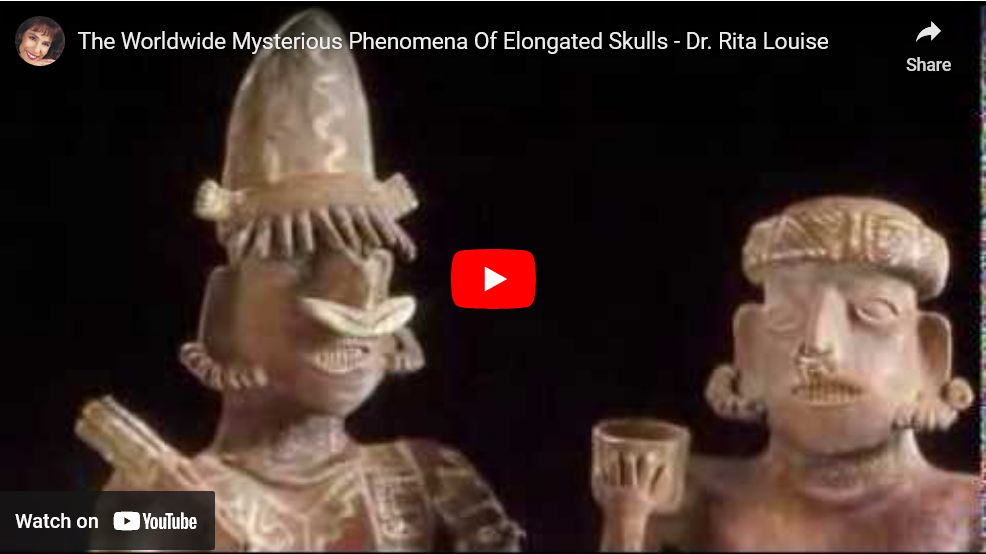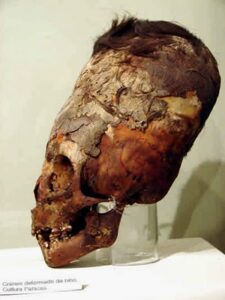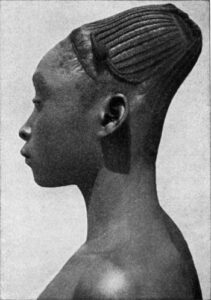Cranial Deformation / Elongated Skulls
Why Have Multiple Societies & Cultures
Around The World Participated In This Bizarre Tradition?
Societies around the world portray distinct characteristics which define their culture. From the clothes worn; the language spoken and the customs and traditions that are passed from generation to generation, each of these can provide insights into a cultural group. There are, however, a number of universal customs that are practiced on each continent around the globe. They include circumcision, death and burial rituals and cranial deformation. These traditions originated in our remote past. Their purpose and meaning seemingly lost to the sands of time.
It was once believed head modifications (elongated skulls) developed in Egypt, and then spread around the world. Researchers have concluded that this phenomenon was not isolated to one geographic area and then disseminated out into the surrounding areas. Instead, this bizarre hallmark of ancient societies sprang up around the world in different cultural groups independently. Many have come to believe it to be an inherent step in the evolution of a group’s culture.
What Is Cranial Deformation (The Method Used To Produce Elongated Skulls)
Cranial deformation is a distinct and painful tradition. The objective of cranial deformation is to elongate the shape of the head. This procedure, once performed, cannot be reversed. More importantly, individuals who have had the procedure performed, unlike circumcision cannot conceal it. It is a permanent visible marker that identifies not only a cultural group, but also select individuals within that society.
When a child is born, the infants head is fashioned or molded into a uniquely long and slender shape. The simplest method a caregiver employed was to put pressure on, or gently massage the child’s head daily until the desired shape is achieved. The second method constrains the child’s head in a mechanical device which, over time, will produce the desired elongated shape.
Head modifications are always performed during infancy. This is when the cranial bones are still tender and pliable and the sutures between the cranial bones are unfixed. This allows shaping or reshaping the head. But why would a mother or caregiver subject her child to such a painful and ongoing process?
The Origin Of Cranial Deformation
Skulls displaying clear signs of cranial deformation surfaced in the archaeological record of the early Neolithic Era starting around 10,000 BCE. The practice of head modifications during the Neolithic era (prior to 5000 BCE) appears episodic. This may be due to the number of individuals whose heads were modified or could be tied to the limited number of remains that have been unearthed.
Some of the earliest examples of elongated skulls discovered were unearthed in south-eastern Australia in Coobool Creek and Kow Swamp. Remarkably, finds that date to about the same time were also found in the Shanidar Cave in Iraq. In the eastern highlands of Brazil, a skull was recovered from Confins Cave that dates back to 7566 BCE.
Starting around 5,000 BCE, the tradition of skull modification appears to have expanded. This assumption is based upon the increased number of remains with elongated skulls recovered. Some researchers believe that the convention of cranial manipulation mushroomed as early hunter-gather societies began to coalesce into urban environments. Figurines with deformed crania also start to appear in the archaeological record further supporting the antiquity and distribution of this custom.
Elongated Skulls In Modern Times
In the modern world, the tradition of cranial deformation is often associated with ancient indigenous cultures and not with advanced western civilizations. If it was practiced in the western world, one might assume that it occurred sometime in our remote past and was abandoned by civilized society. This is far from the case. In Europe, researchers, such as neurologist and psychiatrist Achille Foville, documented the practice of cranial deformation in France. Surveying the crania of inmates at a French public asylum, in 1833, he evaluated 431 individuals at the facility. His findings revealed a remarkable 50% of the population with clear signs of deformation, with some of them being considered severe in his estimation.
Regardless of where they have been found, the majority of modified skulls possess striking similarities. Transverse grooves or depressions have been observed on the skulls indicating pressure was applied to the head. These early finds, as well as the many other more recent discoveries, all show clear signs of intentional manipulation and were not the result of genetic or congenital issues.
There are two primary forms of artificial cranial deformation – tabular and circumferential.
Tabular Cranial Modifications
Tabular cranial modifications involve the compression of the front or front and back of the child’s skull by cradle boarding or other cephalic apparatus. It is the most prominent type of deformation found around the world and includes unintentional, yet unnatural, variations to the cranium. After birth, a board is placed on the child’s head and is bound in place. This flattens the child’s forehead. If the child’s head is placed between two boards, one in the front and another in the back and bound, the compression results in a more exaggerated and distinctive head shape. This type of modification causes the skull to expand laterally and superiorly.
Garcilaso de la Vega writing in 1609 described the methods used by the inhabitants of certain regions of Peru. He states:
“From birth they pressed their children’s skull between two planks tied together at the ends, which they tightened a little every day… After three years, a child’s skull was deformed for life, so they removed the apparatus.”
Circumferential Cranial Modifications
Head modification by means of the tabular method can occur unintentionally as a side effect of child care practices. Circumferential modifications, on the other hand, are unquestionably produced intentionally. Constricting bandages are wrapped like a tight ring around the skull forcing its growth upright. This method reduces the diameter of the skull while pushing the cranium upward and backward. Up to three bands were used to produce a conical head form. Evidence, based upon skulls discovered, suggests that the number of bands applied to select individuals within a community varied. The more bands used produces a more exaggerated skull shape. Tight fitting caps or bonnets were also used to create an elongated appearance to the head.
The Mystery Surrounding Elongated Skulls
Surveys of cranial deformation around the world have also unveiled one other remarkable find. If the tradition of cranial deformation had originated in one location and then spread across the globe, then one would expect to find large geographic areas in which tabular head shaping methods were uniquely employed and then others that utilized the circular method. An example of this would be the discovery of only tabular modifications in South and Mesoamerica and circumferential style modifications in Egypt and the Levant.
What we find are many instances where both types are being utilized in relatively close proximity to one another. For example, for the Aymara culture of the highland area near Tiwanaku, Brazil, the predominant practice was of circumferential compression. At the same time, in the coastal areas of Peru, tabular deformations were prevalent. Even in the island countries of Oceania, circular modifications have been found in countries such as Malekula and New Hebrides, while tabular modifications are practiced on the neighboring Solomon Islands and New Caledonia. They have also discovered that the methods, customs, and traditions used appear the most intense in specific geographic areas and deteriorate as one moves away from this focal point until finally the practice is no longer performed. This dispersion suggests that this rite was established in chief cultural centers and then spread into the surrounding areas.
Accentuation Of Elongated Skulls
In addition to the physical manipulation of the cranium, other measures were employed by many cultures to accentuate this modified form. In some cultures, the hair was pulled back and braided, put into a bun or topknot to further accentuate the elongated shape of the head. Pointed hats are also believed to have been worn to exaggerate the shape of the head. The pointed hat that adorned the head of many of the Egyptian pharaohs is an example of this tradition. In Egypt, only the nobility could wear tall pointed hats symbolizing their elevated status.
The donning of pointed hats was not limited to Egyptian royalty. Several conical brimless extremely long gold hats have been discovered in central Europe with the earliest one dating to about 1400 BCE. These obviously were not worn by the common man. In ancient Greece, slaves that were released from bondage were allowed to wear a pointed hat called a pileus. Did this indicate their increased social status? Early art also shows image after image of individuals wearing pointed hats. Were they emulating this ancient tradition with their clothing? Even today, the guest of honor at a birthday party will don a pointed hat to symbolize his importance. Could this tradition be a remnant of a long-forgotten past?
Why Did People Begin Elongating The Skull
Why did people around the world begin this practice? It has been concluded, especially with circumferential compression, that hats, bands or other apparatus was intentionally applied and was not the unintentional outcome of child-rearing practices. Unfortunately, the original meaning or ritual significance has essentially been lost and in many cases has been replaced by the blind following of an ancient tradition. In the few traces of beliefs that have survived we do find a consistency and general theme which may reveal at least in part some of our ancestor’s underlying motivations. Many cultures believe that an elongated head indicates increased intelligence. It was also thought to enhance one’s beauty or was a trait to be admired. Some cultures believe it will make them look fierce in war.
A correlation between deformation and the appearance of social classes has also emerged. In many cultures, a deformed head was an indicator of increased social position. Extending throughout Europe, a large number of elongated skulls have been discovered in ancient tombs. These finds by themselves suggest that the interred individuals had an elevated social standing which warranted a more elaborate burial. Parallel finds have been unearthed in Peru. Some of the most ill-shaped heads were discovered in some of the largest and finest tombs side by side with skulls of normal size and proportion.
Why Elongate The Skull In The First Place?
A chief or members of the royal family, for example, may exhibit increased deformation, while a priest, shaman or individuals with local eminence may display a less intense modification. Thus, he who has the longest head was the most noble. Studies into indigenous cultures like the Native American Chinooks of the Pacific Northwest relay that slaves were never permitted to practice this ritual. The ancient Macrocephali people of Africa, of whom the word macrocephalic is derived, believed that men of low birth had no right to observe this custom. This may explain in part why this modification was not equally employed by all members of a community.
Some cultures report that the practice of cranial deformation was passed on as an edict from the gods. Ancient Polynesian tradition informs us that this right was brought to them by a group of light-skinned people whose home was in the sky. In Central America, claims are made that this custom was employed because the gods told their ancestors to do it. They go on to state that the practice makes it easier to carry burdens. In Peru, the god Manco Cápac ordered the people to perform this strange ritual so that their children would be weak, submissive and obedient.
The Practice Of Cranial Manipulation
It is unclear why the intentional manipulation of the skull was adopted. This practice once decided upon, takes years to unfold before a child is grown and enters into a position of power or prestige. It seems evident that this painful procedure was not a response to some innate primal impulse. It seems hard to fathom that a parent or caregiver would want to inflict years of relentless pain and discomfort on an infant based upon an ancient fashion trend.
Implementation of elongation would also require long termed planning and commitment on the part of the caregiver for it to ever flourish. If it were something that humanity was compelled to do as part of its social evolution, then it would only make sense that it would be found more widely distributed. This practice, however, was confined to certain classes and specific geographic areas. It seems obvious that this tradition was so important to our ancestors that it has lingered and has been passed down through time to the modern era – its meaning and real significance lost.
The willing decision to adopt this practice around the world overnight seems unlikely. Perhaps, this is not a haphazard invention of our ancestors, as is currently believed. It seems more likely this practice was imposed upon the people by an outside source. The special knowledge required by caregivers to implement this delicate procedure appears to have developed overnight. Then, when we take into account the uniformity of the methodology, tools, and techniques used by cultures around the world, it is difficult to accept that the practice originated independently.
Who Imposed Tradition Of Elongated Skulls
French naturalist, Jean Louis Armand de Quatrefages de Bréau, writing in 1889, did not believe that the extraordinary similarities between the skulls could have come about autonomously or as a natural impulse of the human race and asserts that the evidence points to a worldwide culture in archaic times. Who were these people who imposed the tradition of cranial deformation on our ancestors? Survivors of the great flood as recorded in the Bible? Remnants of the Atlantian legacy? Or members of an extraterrestrial race? We do not have the answer to that question right now, but as more evidence is unearthed the true origin of this practice will be revealed.
© Copyright Rita Louise, Inc. – soulhealer.com. All rights reserved.
Learn more about this and other weird body modifications that ancient people around the world practiced in my book Stepping Out Of Eden. Order your copy Today!







